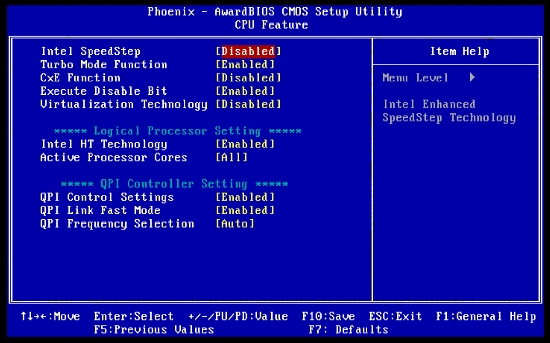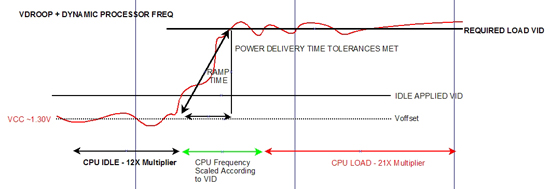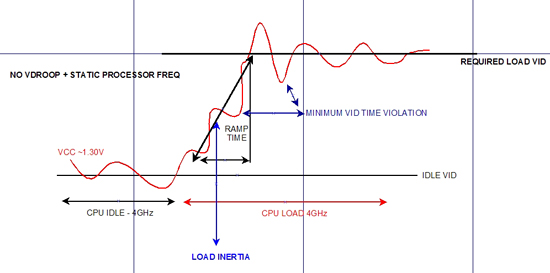EVGA X58 Classified - First Look
by Rajinder Gill on February 27, 2009 5:00 AM EST- Posted in
- Motherboards
More BIOS Stuff

Intel SpeedStep: You can set this to Enabled for 24/7 overclocking. This setting will change the CPU multiplier dynamically depending on the processor load. A fine control of idle and full CPU load changes is available under the Vista OS in the power management option.
Turbo Mode: This locks the turbo state multiplier to "on" irrespective of system loads. When this function is active, an i7-920 processor will retain a 21X multiplier on all four physical and logical cores, regardless of the selected multiplier on the frequency/voltage control screen.
CxE Function: For maximum performance in score oriented benchmarking, set CxE to Disabled. The multiplier idle~ramp period, power saving, and cache flushing employed by some C-states increase L3 cache latency, which reduces scores in sensitive benchmarks. For 24/7 use there is no harm in activating SpeedStep and C1/C1E states to conserve a small amount of power during low CPU load and idle conditions. These functions should be used in conjunction with CPU power VDroop to maximize system stability. VDroop is a proverbial hornets' nest of often-misinformed opinions, so we will take a brief look at VDroop and where things can become a little nasty on certain motherboards.
C states and SpeedStep are reliant on stable power delivery to the CPU during multiplier step changes. Using VDroop with these two functions enabled ensures that CPU voltage delivery remains within specified tolerances. The Nehalem architecture is also able to dynamically alter VID values according to TDP (total power and current drawn). Hence, the inclusion of these functions on all i7 boards by default; it is how Intel designed these processors to work. Here is a very simple illustration of how this takes place.

VID denotes applied VCore while VCC denotes the real-time voltage level; these are not to exact scale and are for illustrative purposes only.
The hold period of SpeedStep together with current and power load sensing by the processor allows VCC to settle before the maximum clock multiplier is enforced while VID tolerances remain observed. Voltage excursions that are drastically above or below VID not only can breach processor warranty tolerances with voltage spikes, but also give rise to increased power supply settling times as the PWM circuit feedback loop reacts to the initial power delivery error. During any form of oscillation, the power supply bandwidth is compromised for a small period of time at the resonating frequency. Ultimately, this increase in power line settling time can result in system instability and bring about the shortening of component lifespan. This is the exact reason that Intel set forth design tolerance margins that have to be observed to satisfy stock operation. It is up to the board manufacturers to include and satisfy these safety margins according to the capabilities of the circuits they choose.
Running a board with "no VDroop" under these types of condition may not only violate VID delivery guidelines but can also make the system unstable. Most PWM controllers are designed according to VRM 11.1 spec (they have to be at this point). The VDroop function is a pivotal part of the engineering and development process of these controllers, and configuring this function properly on a board maximizes the performance of the controller in question. It is for this reason that disabling VDroop on some boards may actually cause the voltage to rise when the processor goes into a load state. Disabling VDroop essentially changes the way the controller was designed to work. Custom implementations are obviously possible that surpass the Intel specification guidelines by a wide margin; however, VDroop and settling time are still important facets of high speed and high current operation.
In the following scenario (without VDroop), and with SpeedStep disabled, not only must the PWM controller stabilize VCC when the processor enters load state, but it also has to ramp VCore upwards to reach stable VID for the applied processor frequency - a double whammy for the PWM controller and output FETs. The CPU is overclocked and sitting at a static 4GHz speed regardless of idle or load conditions.

If VCC breaches the minimum processor frequency dependant VID for long enough the result is a system crash. The user will usually counter this effect by adding more voltage so that the idle VID is closer to the required load VID.
Fortunately, not all boards ramp VCC like this with VDroop disabled; if you happen to have one that does, enabling VDroop is not a bad idea at all. In the case of an overclocked processor, real-time software loads that modulate rapidly cause havoc for the PWM controller and FETs, as they fight the inertia of the load change and attempt to raise VID (VCC) while trying to stabilize the load line - not good. Compounding problems further is users seeing voltage fluctuations or a stable voltage as reported by onboard sensors contradicting any of the power delivery guidelines. Unfortunately, these sensing devices are only satisfactory for reporting a crude average voltage value and are nowhere near fast enough to show the real time VCC fluctuations that are occurring in the KHz ~MHz region. Simply put, voltages reported by the BIOS/sensor and software should not be trusted when trying to confirm the presence of voltage spikes on the VCC line.
With all this in mind, we always utilize VDroop for all of our "everyday" overclocking results. On this platform, we do so even when using LN2 cooling as the i7 architecture does not seem to need bucket loads of voltage to reach its full overclocking potential. Suitably engineered boards incorporate VDroop in a manner where VCC sags by around 0.07V under full load even when you apply 1.6V~1.7V in BIOS. So long as you know what the approximate full load VCore is, you can work around it without a problem. In fact, on boards that support dynamic VID changes when the processor is overclocked, we utilize this function for our 24/7 overclocks.
The Classified implementation of SpeedStep and C power states at the time of publication support dynamic VID at stock processor voltage (set to AUTO in BIOS). Once you move past the AUTO value for VCore, VID will remain at the BIOS applied voltage without changing dynamically at idle or load states. That means you don't quite get the IDLE VCore reduction when the processor is overclocked using any other voltage apart from AUTO in the BIOS. This is one of the compromises in having a board designed to push components as far as they will go by using a PWM controller geared for high current delivery far beyond stock speeds.
The 10-phase Volterra solution seems more than qualified to handle an overclocked Nehalem CPU's slew rate demands with its freakish over-engineered specifications. Using the "without VDroop" function on this board does not result in VID being raised during load conditions. However, for the sake of best power delivery and system stability, we still recommend you use VDroop for the best overclocking potential. No matter how good a controller is, VDroop will always help deliver the most stable power to the CPU.










22 Comments
View All Comments
rogguy - Thursday, March 12, 2009 - link
this board is mediocre compared to asus ROGEverlong19 - Thursday, March 12, 2009 - link
How can you have a triple GPU setup using dual slot cards and have room for a physics card/sound card?Only way it might be possible is putting the 3rd card in the 4th PCI-E slot, but that would overlap the USB headers etc. The PCI slot gets covered by the 2nd GPU, so any PCI sound cards can't go in there, either.
MadMan007 - Saturday, February 28, 2009 - link
The important thing I take away from this preview has nothing to do with the board itself but rather eVGA's expanding custom software and software/hardware efforts. It's really neat to see a company like eVGA make a push in this direction going well beyond other mobo companies with their basic monitoring software and other graphics rebadgers.MasonStorm - Saturday, February 28, 2009 - link
You could certainly do it, as stated, by plugging one of the dual-slot cards into that last slot, and having it hang over the edge of the board - requiring an extra big case. But another way is to use liquid-cooled versions of the cards, cutting them all down to single-slot size. In any event, it doesn't matter where you place them, since you can use three of the soft, bendy SLI bridge connectors to make your own triple-SLI connection. You don't have to use anybody's firm, fixed triple-SLI connector. Just Google around to see how to use the three individual, soft, bendy connectors.Casper42 - Friday, February 27, 2009 - link
Question on this comment:The slot configuration allows running three dual slot GPUs and a single slot PhysX card or other PCI-E peripheral
In looking at the pictures, this board only has 7 slots total with the x1 being at the top.
If you used 3 Dual Slot GPUs, that would be 3 x 2 = 6 + the x1 = 7
So where exactly are you putting a PhysX card?
The only possibility I see is if you use an 8 or 10 slot Case and stick the 3rd Dual Slot GPU in the very bottom slot such that it hangs off the bottom of the mobo. But in this case, the normal 6 connector Triple SLI Bridge wont reach the 3rd card.
Am I missing something here?
PS: Dont get me wrong, I like the design of the board.
Rajinder Gill - Friday, February 27, 2009 - link
You are right the 3rd SLI card would go in the last PCIe slot, with a dual card overhanging. An SLI bridge supporting this will ship with the retail board.Board dimensions are 310mmX265mm btw. Big case territory.
regards
Raja
cesthree - Friday, February 27, 2009 - link
Remember the awesome 7X0i series of motherboards? Especially the last one with the NF200 on it? It's called a 790i "Ultra" chipset.There are only a few people who ever had problems with the 7X0i series motherboards when using multiple GPU's. Not one person ever complained about things like "freezing" or "hard locking" or "data corruption." Especially not at stock speeds.
Just like there is absolutely no sarcasm in my last paragraph.
What fool would by the "Classified" EVGA motherboard? It's got negligible performance increases. Why go through that much trouble for all of the 5 people on earth who would purchase it and use it with 3-4 GPU's + 30" or bigger monitor.
Mark my words. The NF200 addition to the X58 that EVGA already had going GREAT for them, will bring them problems on the level with the last batch of shoddy, Nvidia tainted motherboards.
I am going to put this in all my sigs from now on:
"Nvidia, for the love of god, please stop crippling motherboards and just stick to GPU's."
Von Matrices - Friday, February 27, 2009 - link
From what I can tell from sources online, the NF200 bridges 16 PCIe 1.1 lanes to 32 PCIe 2.0 lanes. What is there to gain by using the NF200 over just using four PCIe x8 2.0 lanes of bandwidth from the IOH? With the NF200, you get ~4GB/s bandwidth to the IOH per graphics slot compared to ~8GB/s with a native solution, and the bridge adds additional latency, which further reduces performance, and additional cost. Why would EVGA use it then? Are there any advantages to it?Zak - Friday, February 27, 2009 - link
Question. 920 can be easily o/clocked on most boards to 4GHz and peak under 80C under full load using a good air cooler and be perfectly stable. But how long will that CPU and mobo last at these temps and bumped up voltages if used daily? The temps can be addressed by water cooling but how damaging is running CPU at 1.4V, QPI at 1.5V/7.2GHz for long time?Z.
Agoniesfury - Saturday, January 23, 2010 - link
Well I can testify to this comment, and say that I'm an enthusiast and like to buy top rated tech and push their limits, over 8 months ago I purchased a R2E to be used with my 1yr old 920 only bad part was the 920 was a C0 but nonetheless I was able to get to 4.1ghz for benching and everyday stablity "non prime stable", which did fine until 2weeks ago when the board just blinked at me and nothing more, well thank god for rma! So I did decide to upgrade to a classified 760, well in my case I lost some of the bells and whistles that the asus had but was better greeted with the hardware imporvements and design of the evga has. I'm now at 4ghz and climbing 8hrs+ prime stable where as the r2e only was prime stable up to 3.6. So I think both boards are great but the classy is a hair better and hope it lasts!P.S. I've been overclocing for about 10yrs and I never had a chip fry on me it's always the mobo from decay I asume, and the 920 it's self has been through 2 powersupplies and three mobo's.